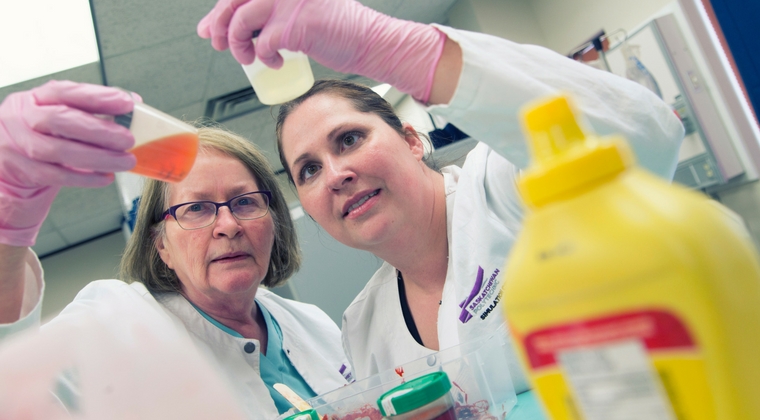
New cookbook outlines recipes for making realistic fluids and materials for use in a simulated learning environment
High-tech mannequins and healthcare technologies beeping at different intervals are
an integral part of Saskatchewan Polytechnic’s simulation labs, where health sciences
and nursing students learn and study. The one thing missing from these applied learning,
high-tech labs were materials and substances that simulate the bodily fluids and textures
of practicing health care on a real human being.
That’s why Dr. Ursula Osteneck, program head, Continuing Care Assistant program and Jennifer Braaten, simulation centre coordinator, wrote a SIM lab cookbook. The cookbook, takes the SIM lab to the next level with a series of instructions for creating substitute bodily fluids that look, feel and smell, just like real thing.
“There is no limit to what we can prepare, it just takes imagination and a bit of time,” says Osteneck.
“I use a rolled roast, pork or beef, with a piece of bone inserted in the middle of the advanced tissues. The roast is much more realistic and similar to injecting into a buttock as compared to a naval orange, which has been used in the past,” says Osteneck.
Known as “SIM labs” to staff and students, the specialty labs are designed to give students the opportunity to learn and practice in a next-to-real health-care environment. The ultimate goal is to help prepare students for real life pressures and experiences in the health-care system.
As a teaching tool, the cookbook also includes instructions for recreating typical practices, such as removing surgical drains, to help the student get used to the tactile feelings associated with the work. Exposing students to these elements means that when they begin interacting with real patients, they are mentally prepared for what might come their way.
“Students find the realism exciting, and it is realistic to a certain degree. The students curl up their noses at the make-belief stool sample, but learn to get used to it so they aren’t making the same face in front of a patient,” says Osteneck.
It’s this kind of applied research project that the Office of Applied Research and Innovation is proud to be a part of.
“This cookbook helps to enhance the education of our students,” says June Anonson, former interim director of the office of Applied Research and Innovation. “It’s also a tool we can share with our colleagues at other post-secondary institutions who use similar simulated teaching methods.”
While the benefits to our students are invaluable, the project also aligns with the institution’s strategic vision of becoming Canada’s top choice polytechnic by 2020.
“It reinforces Sask Polytech’s position as an educational leader in nursing and other health science professions. It also sets us apart from other polytechnics in Canada — we developed a tool other institutions are using in their classrooms,” says Anonson.
Osteneck says she’s always refining recipes or designing new ones. Future possible
updates include incorporating “smells” and demonstrating chest tube “tidaling,” the
process of fluids moving within the chest tube collection device as the client breathes
in and out.
Published March 2017.

